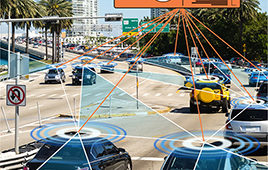Why Mars again? A Look at NASA’s Latest Venture
 |
|
NASA’s Curiosity rover and its parachute were spotted by NASA’s Mars Reconnaissance Orbiter as Curiosity descended to the surface on August 5 PDT (August 6 EDT). The High-Resolution Imaging Science Experiment (HiRISE) camera captured this image of Curiosity while the orbiter was listening to transmissions from the rover. Curiosity and its parachute are in the center of the white box; the inset image is a cutout of the rover stretched to avoid saturation. The rover is descending toward the etched plains just north of the sand dunes that fringe “Mt. Sharp.” From the perspective of the orbiter, the parachute and Curiosity are flying at an angle relative to the surface, so the landing site does not appear directly below the rover. Courtesy of NASA/JPL-Caltech/Univ. of Arizona |
NASA’s new robot rover named Curiosity landed safely late Sunday in a huge crater near the equator of Mars and will soon begin its scientific studies. This marks NASA’s seventh landing on the red planet and is its 19th Mars mission, including those by orbiters and other spacecraft.
The arrival was an engineering tour de force, debuting never-before-tried acrobatics packed into “seven minutes of terror” as Curiosity sliced through the Martian atmosphere at 13,000 mph. In a Hollywood-style finish, cables delicately lowered the rover to the ground at a snail-paced two miles-per-hour. A video camera was set to capture the most dramatic moments — which would give earthlings their first glimpse of a touchdown on another world.
The nuclear-powered Curiosity, the size of a small car, is packed with scientific tools, cameras and a weather station. It sports a robotic arm with a power drill, a laser that can zap distant rocks, a chemistry lab to sniff for the chemical building blocks of life and a detector to measure dangerous radiation on the surface.
It also tracked radiation levels during the journey to help NASA better understand the risks astronauts could face on a future manned trip.
Why Mars again?
The big unknown remains. Scientists want to know if any form of life ever existed there, and that means microscopic organisms.
Curiosity is the most ambitious effort ever to burrow into that question, though it is not equipped to look for actual microbes. During its two-year exploration, it will try to answer whether the giant crater had the right conditions to support that type of life.
What will Curiosity do?
Curiosity carries a toolbox of 10 instruments, including a rock-zapping laser and a mobile organic chemistry lab. It also has a long robotic arm that can jackhammer into rocks and soil.
It will hunt for the basic ingredients of life, including carbon-based compounds, nitrogen, phosphorus, sulfur and oxygen, as well as minerals that might provide clues about possible energy sources.
How much did this cost?
$2.5 billion. Development took longer than planned, delaying the mission for two years and costing $1 billion more than the original budget. But that extra time is credited in part with the safe landing of the one-ton rover, which required new technologies and highly complicated maneuvers.
When will we send astronauts to Mars?
President Barack Obama has set a goal for astronauts to orbit Mars by the mid-2030s, followed by a landing. Before that can happen, the plan is to send astronauts to an asteroid first.
Copyright 2012 The Associated Press




